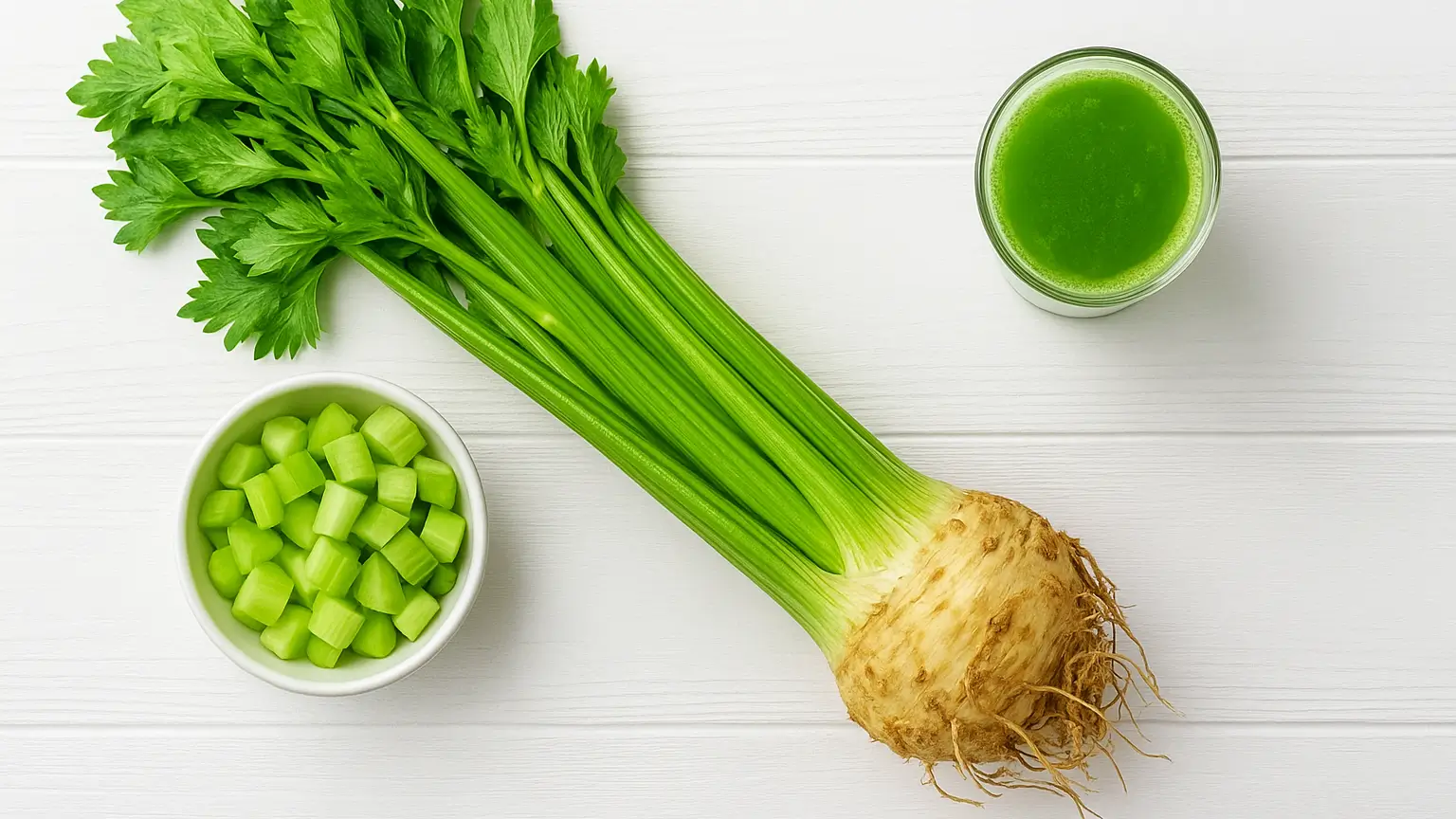What is Pravi Celer?
Pravi celer is a traditional type of celery (Apium graveolens) that includes both the stalk and root. The word “pravi” comes from Slavic languages and means “real” or “true”, so this is the real deal. Not mass produced, grown without chemicals, genetic changes or artificial alterations – valued for its natural nutrients.
This plant is part of the Apiaceae family, which includes carrots, parsley and fennel. Unlike store bought celery, pravi celer uses both the stalks and the root (celeriac), so you get more nutrients. The root is richer and earthier than the stalks and may be more concentrated in nutrients.
In parts of Europe like the Balkans and Slavic regions, pravi celer is used in traditions beyond cooking. People use both the stalk and the root in food and folk remedies. Every part of the plant can be used – from the stalks to the fragrant leaves and even the nutrient rich root.
Traditionally pravi celer was used as food and medicine. Folk healers said it could help with digestion, circulation and easing tension. Remedies claimed it could support kidney and bladder health, stimulate stomach juice production and reduce bloating.
Today interest in pravi celer comes from its nutrient profile. Low in calories, it’s rich in vitamins, minerals and natural compounds. That’s why it’s remained important in cooking and wellness for so long.
Pravi celer is the original form of the vegetable – the one your grandmother might have grown in her backyard. It has a bold taste, a rich aroma and is often grown with traditional or organic methods. That’s why it’s different from factory farmed celery which may lose some of its nutrients due to industrial practices.
Recent Posts
How Pravi Celer May Support Health
Pravi celer contains nutrients and compounds that may support different areas of health. Research and tradition suggests it may support digestion, circulation and hydration.
Digestive Support
- Soluble and insoluble fiber to maintain regular bowel movements
- Healthy gut microbiome
- Natural enzymes to stimulate gastric juice production for better nutrient absorption
- High water content to move food through the digestive system
Heart and Circulation
- Phthalides in celery may relax arterial muscles and improve blood flow
- Celery extract may support healthy blood pressure (results vary)
- Potassium for sodium balance and normal heart rhythm
- Antioxidants like apigenin for vascular health
Hydration and Detox Support
- 95% water so naturally hydrating
- May support kidney function by increasing urine output and removing excess sodium
- Traditionally used for liver health and reducing bloating
Key Nutrients in Pravi Celer
Pravi celer is nutrient dense and low in calories—16 kcal per 100g. It has:
- Vitamin K (29.3 mcg per 100g): Blood clotting and bone health
- Vitamin C (3 mg per 100g): Antioxidant for collagen production and immune function
- Potassium (260 mg per 100g): Heart rhythm, blood pressure and muscle function
- Dietary Fiber (1.6 g per 100g): Digestion and satiety
- Antioxidants: Flavonoids, luteolin, apigenin—anti-inflammatory and protective properties
- Folate (36 mcg per 100g) and Magnesium (11 mg per 100g): Energy metabolism and overall wellness
Nutritional Value of Pravi Celer
Hydration, low calories and essential nutrients—add this to your balanced diet.
Myths and Truths
Myth: Celery burns more calories than it has
Science doesn’t support the concept of “negative calorie” foods. Celery is very low in calories but doesn’t burn more than it has.
Myth: All celery is the same
There are different types of celery—self blanching, Pascal (green), celeriac. Pravi celer, often organic or heirloom, is considered more flavorful and nutrient rich.
Fact: Both stalk and root are included
Unlike regular store celery, pravi celer has the crunchy stalks and the root (celeriac), both used in cooking and wellness traditions.
Fact: Used in traditional medicine for centuries
Pravi celer has been used in folk remedies for digestion, circulation and relaxation. These uses are traditional and not medical treatment.
Myth: Celery juice is a fad
Celery juice is a wellness trend. While it can be hydrating and nutritious, exaggerated claims (like “undiscovered cluster salts”) have no scientific backing.
FAQs
Q1. What’s the difference between Pravi Celer and regular celery?
Both stalk and root (celeriac) grown without chemicals or genetic modification. Stronger taste and more nutrients (though this varies by variety and growing conditions).
Q2. Does it aid digestion?
Fiber for bowel regularity, natural enzymes for nutrient absorption.
Q3. Can it help with blood pressure?
Some compounds in celery support healthy circulation but effects vary and not medical advice.
Q4. What nutrients does it have?
Vitamin K, Vitamin C, potassium, fiber, antioxidants, folate, magnesium.
Q5. Is the “negative calorie” myth true?
No, celery doesn’t burn more calories than it provides. But it’s a healthy low calorie food.
Conclusion
Pravi celer is traditional wisdom and modern nutrition. Low calorie, hydrating and has important vitamins, minerals and antioxidants. Digestion, hydration and heart health are based on tradition and early studies. More research needed for medical confirmation.
If you like whole foods, try adding pravi celer to your meals. It’s versatile, nutritious and connects you to ancient food traditions.
Disclaimer: This article is for informational purposes only and does not provide medical advice. Always consult a healthcare professional before making dietary or health-related changes.

